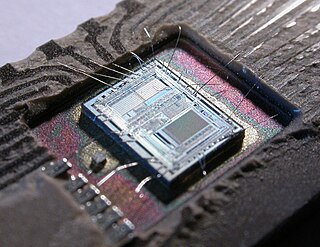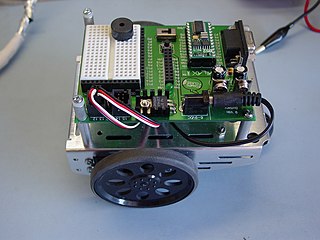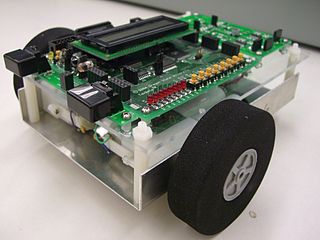
A microcontroller is a small computer on a single VLSI integrated circuit (IC) chip. A microcontroller contains one or more CPUs along with memory and programmable input/output peripherals. Program memory in the form of ferroelectric RAM, NOR flash or OTP ROM is also often included on chip, as well as a small amount of RAM. Microcontrollers are designed for embedded applications, in contrast to the microprocessors used in personal computers or other general purpose applications consisting of various discrete chips.

Lego Mindstorms was a hardware and software structure which develops programmable robots based on Lego building blocks. Each version includes computer Lego bricks, a set of modular sensors and motors, and parts from the Lego Technic line to create the mechanical systems. The system is controlled by the Lego bricks which act as the brain of the mechanical system.
BEAM robotics is a style of robotics that primarily uses simple analogue circuits, such as comparators, instead of a microprocessor in order to produce an unusually simple design. While not as flexible as microprocessor based robotics, BEAM robotics can be robust and efficient in performing the task for which it was designed.

The BASIC Stamp is a microcontroller with a small, specialized BASIC interpreter (PBASIC) built into ROM. It is made by Parallax, Inc. and has been popular with electronics hobbyists since the early 1990s.
PBASIC is a microcontroller-based version of BASIC created by Parallax, Inc. in 1992.

PICAXE is a microcontroller system based on a range of Microchip PIC microcontrollers. PICAXE devices are Microchip PIC devices with pre-programmed firmware that enables bootloading of code directly from a PC, simplifying hobbyist embedded development. PICAXE devices have been produced by Revolution Education (Rev-Ed) since 1999.
The XGameStation is a series of embedded systems, primarily designed as a dedicated home video game console, created by Andre LaMothe and sold by his company Nurve Networks LLC. Originally designed to teach electronics and video game development to programmers, newer models concentrate more on logic design, multi-core programming, game programming, and embedded system design and programming with popular microcontrollers.

BOE–Bot is short for Board of Education robot. It is the trade name of a robot kit that is used in junior high, high school and college robotics classes. It consists of a main circuit board and breadboard, a plug–in BASIC Stamp microcontroller, two servo motors to drive the wheels, and an aluminum chassis that the parts bolt onto. Students can use Erector set parts, Lego blocks, and additional servos to build custom projects. The BOE-bot has been manufactured and sold by Parallax Inc since 1998.

The Parallax P8X32A Propeller is a multi-core processor parallel computer architecture microcontroller chip with eight 32-bit reduced instruction set computer (RISC) central processing unit (CPU) cores. Introduced in 2006, it is designed and sold by Parallax, Inc.

Arduino is an open-source hardware and software company, project, and user community that designs and manufactures single-board microcontrollers and microcontroller kits for building digital devices. Its hardware products are licensed under a CC BY-SA license, while the software is licensed under the GNU Lesser General Public License (LGPL) or the GNU General Public License (GPL), permitting the manufacture of Arduino boards and software distribution by anyone. Arduino boards are available commercially from the official website or through authorized distributors.

The HYDRA Game Development Kit launched in September 2006, and was developed by André LaMothe who designed the prior XGameStation series of consoles. Like the XGameStation, HYDRA is an open system, allowing anyone to create games for it. However, while still designed to teach electronics and programming, the system places greater focus on homebrew games. Compared to the prior XGameStation consoles, the HYDRA uses a more complex and powerful CPU - the then recently released Parallax Propeller processing unit, which has eight 32 bit RISC CPUs called cogs with 32 KB built in RAM and 32 KB built in ROM.
Parallax SX is a discontinued line of microcontrollers that was marketed by Parallax, from a design by Ubicom. Designed to be architecturally similar to the PIC microcontrollers used in the original versions of the BASIC Stamp, SX microcontrollers replaced the PIC in several subsequent versions of that product.

iRobot Create is a hobbyist robot manufactured by iRobot that was introduced in 2007 and based on their Roomba vacuum cleaning platform. The iRobot Create is explicitly designed for robotics development and improves the experience beyond simply hacking the Roomba. The Create replaces its Roomba predecessor's vacuum cleaner hardware with a cargo bay that also houses a DB-9 port providing serial communication, digital input & output, analog input & output, and an electric power supply. The Create also has a 7-pin Mini-DIN serial port through which sensor data can be read and motor commands can be issued using the iRobot Roomba Open Interface (ROI) protocol.

TekBots are programmable robots used by several universities to help students learn some of the fundamental concepts that are found in the fields of computer and electrical engineering.

The Scribbler is a small, low-cost fully programmable intelligent robot with multiple sensor systems. It is capable of auto navigation and interaction with its environment.
Microsoft .NET Gadgeteer is an open-source rapid-prototyping standard for building small electronic devices using the Microsoft .NET Micro Framework and Microsoft Visual Studio/Visual C# Express.
ArduPilot is an open source, unmanned vehicle Autopilot Software Suite, capable of controlling autonomous:











